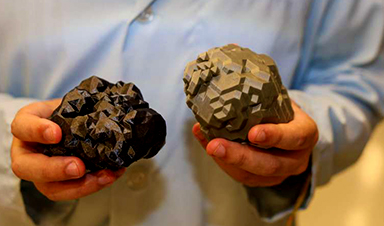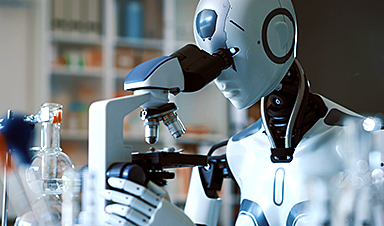Treating cancer can sometimes feel like a game of Whac-A-Mole. The disease can become resistant to treatment, and clinicians never know when, where and what resistance might emerge, leaving them one step behind. But a team led by Penn State researchers has found a way to reprogram disease evolution and design tumors that are easier to treat.
They created a modular genetic circuit that turns cancer cells into a “Trojan horse,” causing them to self-destruct and kill nearby drug-resistant cancer cells. Tested in human cell lines and in mice as proof of concept, the circuit outsmarted a wide range of resistance.
The findings were published today, July 4, in the journal Nature Biotechnology. The researchers also filed a provisional application to patent the technology described in the paper.
“This idea was born out of frustration. We’re not doing a bad job of developing new therapeutics to treat cancer but how can we think about potential cures for more late-stage cancers?” said Justin Pritchard, Dorothy Foehr Huck and J. Lloyd Huck Early Career Entrepreneurial Associate Professor of Biomedical Engineering and senior author on the paper.
“Selection gene drives are a powerful new paradigm for evolution-guided anticancer therapy. I love the idea that we can use a tumor’s inevitability of evolution against it.”
Newer personalized cancer medicines often fail, not because the therapeutics aren’t good, but because of cancer’s inherent diversity and heterogeneity, Pritchard said. Even if a frontline therapy is effective, resistance eventually develops and the medication stops working, allowing the cancer to return.
Clinicians then find themselves back at square one, repeating the process with a new drug until resistance emerges again. The cycle escalates with each new treatment until no further options are available.
“You’re playing a game of Whac-A-Mole. You don’t know which mole is going to pop up next, so you don’t know what is going to be the best drug to treat the tumor. We’re always on our back foot, unprepared,” said Scott Leighow, a postdoctoral scholar in biomedical engineering and lead author of the study.
The researchers wondered if, instead, they could get one step ahead. Could they potentially eliminate resistance mechanisms before the cancer cells have a chance to evolve and pop up unexpectedly? Could they force a specific “mole” to pop out on the board, one that they prefer and are prepared to fight?
What started as a thought experiment is proving to work. The team created a modular circuit, or dual-switch selection gene drive, to introduce into non-small lung cancer cells with an EGFR gene mutation. This mutation is a biomarker that existing drugs on the market can target.
The circuit has two genes, or switches. Switch one acts like a selection gene, allowing the researchers to turn drug resistance on and off, like a light switch. With switch one turned on, the genetically modified cells become temporarily resistant to a specific drug, in this case, to a non-small lung cancer drug.
When the tumor is treated with the drug, the native drug-sensitive cancer cells are killed off, leaving behind the cells modified to resist and a small population of native cancer cells that are drug-resistant. The modified cells eventually grow and crowd out the native resistant cells, preventing them from amplifying and evolving new resistance.
The resulting tumor predominantly contains genetically modified cells. When switch one is turned off, the cells become drug-sensitive again. Switch two is the therapeutic payload. It contains a suicide gene that enables the modified cells to manufacture a diffusible toxin that’s capable of killing both modified and neighboring unmodified cells.
“It not only kills the engineered cells, but it also kills the surrounding cells, namely the native resistant population,” Pritchard said. “That’s critical. That’s the population you want to get rid of so that the tumor doesn’t grow back.”
The team first simulated the tumor cell populations and used mathematical models to test the concept. Next, they cloned each switch, packaging them separately into viral vectors and testing their functionality individually in human cancer cell lines. They then coupled the two switches together into a single circuit and tested it again. When the circuit proved to work in vitro, the team repeated the experiments in mice.
However, the team didn’t just want to know that the circuit worked; they wanted to know it could work in every way. They stress tested the system using complex genetic libraries of resistance variants to see if the gene drive could function robustly enough to counter all the genetic ways that resistance could occur in the cancer cell populations.
And it worked: Just a handful of engineered cells can take over the cancer cell population and eradicate high levels of genetic heterogeneity. Pritchard said it’s one of the biggest strengths of the paper, conceptually and experimentally.
“The beauty is that we’re able to target the cancer cells without knowing what they are, without waiting for them to grow out or resistance to develop because at that point it’s too late,” Leighow said.
The researchers are currently working on how to translate this genetic circuit so that it can be delivered safely and selectively into growing tumors and eventually metastatic disease.
Other Penn State authors on the paper include Marco Archetti, associate professor of biology; Shun Yao, a postdoctoral scholar in biology; Ivan Sokirniy, graduate student at the Huck Institutes of the Life Sciences; and Joshua Reynolds and Zeyu Yang, members of the Department of Biomedical Engineering. Co-author Haider Inam was a doctoral student in biomedical engineering at the time of the research and is currently a research scientist at the Broad Institute of MIT and Harvard. Dominik Wodarz, professor at the University of California, San Diego, also contributed to the paper.
More information: Programming tumor evolution with selection gene drives to proactively combat drug resistance, Nature Biotechnology (2024). DOI: 10.1038/s41587-024-02271-7. www.nature.com/articles/s41587-024-02271-7
News
Nanotech Blocks Infection and Speed Up Chronic Wound Recovery
A new nanotech-based formulation using quercetin and omega-3 fatty acids shows promise in halting bacterial biofilms and boosting skin cell repair. Scientists have developed a nanotechnology-based treatment to fight bacterial biofilms in wound infections. The [...]
Researchers propose five key questions for effective adoption of AI in clinical practice
While Artificial Intelligence (AI) can be a powerful tool that physicians can use to help diagnose their patients and has great potential to improve accuracy, efficiency and patient safety, it has its drawbacks. It [...]
Advancements and clinical translation of intelligent nanodrugs for breast cancer treatment
A comprehensive review in "Biofunct. Mater." meticulously details the most recent advancements and clinical translation of intelligent nanodrugs for breast cancer treatment. This paper presents an exhaustive overview of subtype-specific nanostrategies, the clinical benefits [...]
It’s Not “All in Your Head”: Scientists Develop Revolutionary Blood Test for Chronic Fatigue Syndrome
A 96% accurate blood test for ME/CFS could transform diagnosis and pave the way for future long COVID detection. Researchers from the University of East Anglia and Oxford Biodynamics have created a highly accurate [...]
How Far Can the Body Go? Scientists Find the Ultimate Limit of Human Endurance
Even the most elite endurance athletes can’t outrun biology. A new study finds that humans hit a metabolic ceiling at about 2.5 times their resting energy burn. When ultra-runners take on races that last [...]
World’s Rivers “Overdosing” on Human Antibiotics, Study Finds
Researchers estimate that approximately 8,500 tons of antibiotics enter river systems each year after passing through the human body and wastewater treatment processes. Rivers spanning millions of kilometers across the globe are contaminated with [...]
Yale Scientists Solve a Century-Old Brain Wave Mystery
Yale scientists traced gamma brain waves to thalamus-cortex interactions. The discovery could reveal how brain rhythms shape perception and disease. For more than a century, scientists have observed rhythmic waves of synchronized neuronal activity [...]
Can introducing peanuts early prevent allergies? Real-world data confirms it helps
New evidence from a large U.S. primary care network shows that early peanut introduction, endorsed in 2015 and 2017 guidelines, was followed by a marked decline in clinician-diagnosed peanut and overall food allergies among [...]
Nanoparticle blueprints reveal path to smarter medicines
Lipid nanoparticles (LNPs) are the delivery vehicles of modern medicine, carrying cancer drugs, gene therapies and vaccines into cells. Until recently, many scientists assumed that all LNPs followed more or less the same blueprint, [...]
How nanomedicine and AI are teaming up to tackle neurodegenerative diseases
When I first realized the scale of the challenge posed by neurodegenerative diseases, such as Alzheimer's, Parkinson's disease and amyotrophic lateral sclerosis (ALS), I felt simultaneously humbled and motivated. These disorders are not caused [...]
Self-Organizing Light Could Transform Computing and Communications
USC engineers have demonstrated a new kind of optical device that lets light organize its own route using the principles of thermodynamics. Instead of relying on switches or digital control, the light finds its own [...]
Groundbreaking New Way of Measuring Blood Pressure Could Save Thousands of Lives
A new method that improves the accuracy of interpreting blood pressure measurements taken at the ankle could be vital for individuals who are unable to have their blood pressure measured on the arm. A newly developed [...]
Scientist tackles key roadblock for AI in drug discovery
The drug development pipeline is a costly and lengthy process. Identifying high-quality "hit" compounds—those with high potency, selectivity, and favorable metabolic properties—at the earliest stages is important for reducing cost and accelerating the path [...]
Nanoplastics with environmental coatings can sneak past the skin’s defenses
Plastic is ubiquitous in the modern world, and it's notorious for taking a long time to completely break down in the environment - if it ever does. But even without breaking down completely, plastic [...]
Chernobyl scientists discover black fungus feeding on deadly radiation
It looks pretty sinister, but it might actually be incredibly helpful When reactor number four in Chernobyl exploded, it triggered the worst nuclear disaster in history, one which the surrounding area still has not [...]
Long COVID Is Taking A Silent Toll On Mental Health, Here’s What Experts Say
Months after recovering from COVID-19, many people continue to feel unwell. They speak of exhaustion that doesn’t fade, difficulty breathing, or an unsettling mental haze. What’s becoming increasingly clear is that recovery from the [...]





















